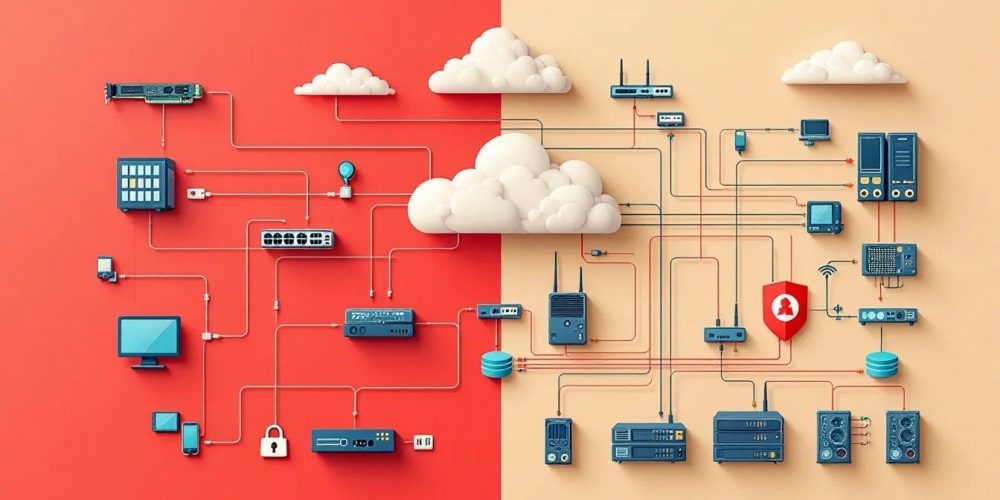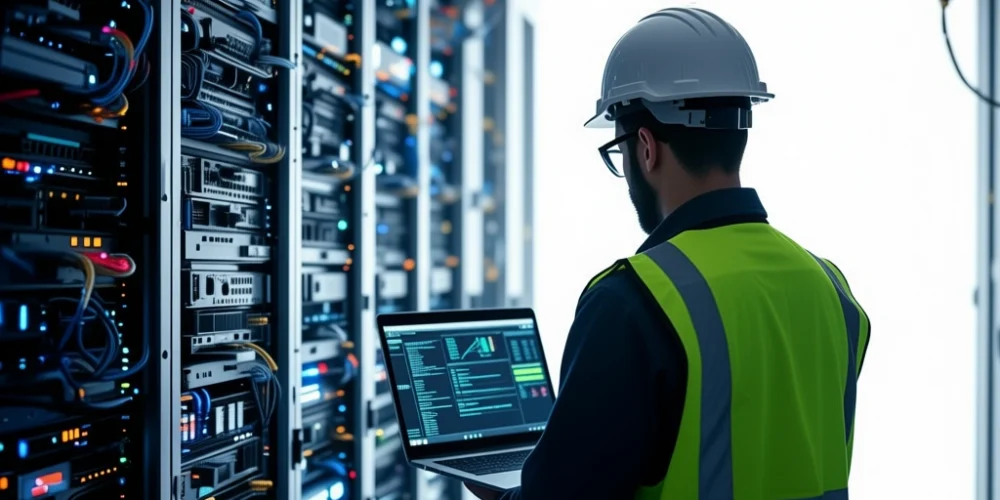Summary: An exhaustive review of important kinds of network hardware, along with their functionality and value to enterprise IT infrastructure. Challenges are discussed, with the best performance, security, and scalability methods. This guide helps IT experts make well-informed procurement conclusions and secure networks for the future.

Network Interface Cards (NICs) are hardware parts that link computers, servers, and other devices to a network. It is a gateway between the internal architecture of a device and the external network infrastructure.
Functionality: NICs convert data from the computer into a network-compatible format, often carrying out the OSI model’s physical and data link layers.
Types:
Enterprise Consideration: High-performance NICs capable of multi-gigabit speeds and bearing advanced features such as Wake-on-LAN (WoL) or TCP/IP offloading should be considered, as they contribute much to network efficiency.
Switches are considered some of the most vital pieces of network hardware. They act primarily at Layer 2 of the OSI model and at Layer 3 on some occasions to route data packets efficiently between various devices inside a local area network.
Type of Switch | Description | Use Case |
Unmanaged Switch | Simple plug-and-play device, no configuration needed | Small offices or networks with minimal traffic management needs |
Managed Switch | Offers advanced features like VLANs, QoS, and monitoring | Enterprise networks requiring segmentation, high performance, and security |
Layer 3 Switch | Combines routing capabilities with switching | Complex networks with multiple subnets requiring internal routing |
Managed switches provide administrators with nuanced traffic control necessary for applications such as VoIP, video conferencing, and cloud-hosted platforms. Definitely, investing in proper switch types is essential to ensure network performance under heavy workloads.
Routers are the network nodes directing packets among networks, sometimes connecting a private network to the Internet. Unlike switches, routers primarily operate on Layer 3, that is, the Network layer, of the OSI model.
Functions:
Router Type | Description | Ideal Deployment |
Edge Router | Connects an internal network to external networks | Headquarters or branch office connections to ISPs |
Core Router | High-capacity router at the backbone of large networks | Data centers and enterprise backbone infrastructure |
Virtual Router | Software-based router running on virtualized environments | Cloud-first or hybrid networks need scalable routing |
For a business that wants its infrastructure to be scalable, it is a matter of no compromise that routers should be selected based on modular interfaces, redundancy features, and security integrations. This would ensure uninterrupted connectivity and allow the network to grow in the future.
Access Points deliver wireless connectivity to any device within the network. They must make flexible, high-availability wireless networks in office, campus, or industrial setups.
Working:
Planning:
Enterprise-class APs support contemporary Wi-Fi standards, ensure seamless roaming, and implement security protocols such as WPA3. Placement and density planning should be done perfectly to avoid dead spots and bandwidth congestion.
Firewalls are security appliances that monitor, filter, and control network traffic according to predefined rules. In modern enterprise environments, firewalls extend beyond simple packet filtering.
Firewall Type | Description | Deployment Scenario |
Hardware Firewall | Dedicated physical device | Enterprise perimeter defense |
Software Firewall | Installed on servers or endpoints | Smaller networks or individual devices |
Next-Generation Firewall (NGFW) | Integrates advanced security features like application awareness, VPN, and AI-driven threat detection | High-security environments requiring multi-layered protection |
Having firewalls integrated with threat intelligence and centralized management guarantees that security policies are applied consistently across different locations. This lessens risk, operational overhead, and, as the name suggests, exposure to cyberattacks.
Acting as the interface between a digital network and an infrastructure of the service provider, modems continue to modulate and demodulate signals to convert digital data for devices into analog signals for transfer and vice versa.
While in enterprise planning, high-performing modems do get neglected at times, they are imperative to making sure the edge of the network connection never becomes a bottleneck.
The physical medium through which data traverses is what counts, along with the hardware it connects to. Network cables ensure reliable and high-speed transmission between devices.
Cable Type | Maximum Speed | Use Case |
Cat5e | Up to 1 Gbps | Standard office networks |
Cat6 | Up to 10 Gbps over short distances | Medium-to-large office deployments |
Cat6a | Up to 10 Gbps over longer distances | Data centers and high-speed LANs |
Fiber Optic | Up to 100 Gbps+ | Backbone networks, WAN, and enterprise data centers |
Connectors: RJ45 is for Ethernet cables; fiber comes with LC or SC connectors, and specialized connectors cater to industrial applications. These connectors help maintain the integrity of a signal. Something as simple as a poor cable could cause packet loss, latency, and poor network performance.
Servers are special network devices that host applications and databases and allow guests to run their own environments. Storage devices, quite usually, work hand in hand with servers, efficiently handling the flow of data.
Abilities, like RAID, hot-swappable drives, and redundant power supplies on high-availability servers and storage, provide for business continuity in instances of high demand or failure.

Even troubles crop up even atop the most flawless network hardware. Enterprises must fix constructive factors hampering their high performance to ensure reliability and security.
Bad cables, damaged cable connectors, or loose connections meddle with data flow, slowing networks and causing downtime. Regular inspection and quality cabling prevent such issues.
Router, switch, and modem installations wear out as time passes. Unplanned failures cause drops in connectivity and degradation in performance. Executing preventative maintenance scheduling will assist in mitigating these risks.
Improperly configured or overly loaded DNS servers keep devices from reaching network resources or websites, putting workflows on hold. Appointing redundant DNS and correctly configuring it shall limit such outages.
Increased temperature due to a lack of cooling damages network devices and reduces their lifespan. Proper cooling should be deployed and temperature monitored.
Server rooms or data centers with poor airflow hasten hardware deterioration. Proper equipment placement and good ventilation management shall avoid failures due to heat.
Being overloaded beyond its designed capacity, everything slows down; latency builds up, and bottlenecks develop. Planning capacity requirements along with upgrading existing hardware is key to avoiding bottlenecks.
If unstable electricity causes power surges or outages, it can affect computers and other hardware. It may be damaged, and network operations may be compromised. Surge protectors and UPS systems ensure stable power delivery.
Backup batteries for routers and firewalls lose effectiveness with repeated use. Regular testing and timely replacements keep these devices reliable when interfacing with power interruptions.
The enterprises should keep high-performing networks by:
With an investment in enterprise-grade hardware, preventive maintenance, and monitoring. The network ensures reliability, growth, and protection for business-critical operations.

Network Drops represent the core of enterprise IT infrastructure. Whether NICs, switches, routers, firewalls, or specialized industrial devices, each imposes a certain meaning of connectivity, performance, and security. Heating, overutilization, and hardware drawbacks compromise network reliability.
This particular solution calls for good procurement planning, regular maintenance by stakeholders, and proactive monitoring. Companies that focus on buying hardware that is of superior quality, scalable, and secure can foster growth, lessen downtime, and improve operational efficiencies.
For network hardware to be of great consequence to enterprises optimizing their network infrastructure, the types of hardware and the problems that this hardware brings into existence must be understood properly. A holistic approach allows organizations to go past entering into a purchase and achieve the long-term goal of network stability.
Network hardware devices protect your network in several modes: by controlling traffic entering or leaving the system, identifying threats, and allowing certain users into the system.
Automation keeps your network secure and efficient. By running updates, backups, and monitoring on scheduled intervals. Hence, it minimizes manual effort and the possibilities of human error.
5G calls for new network hardware equipment to sustain higher speeds and bigger bandwidths. Equipment such as modern routers and access points assists with the heavy punishment of 5G.
Setting up and switching to energy-efficient hardware, recycling older devices through a responsible means, and keeping equipment consolidated as far as possible to save electricity are measures businesses can take to cut down on the environmental impact.
Your network’s ability to grow with your business needs will be assured by investing in scalable hardware, going for modular systems, and keeping yourself aware of the emerging technologies.
"*" indicates required fields
Scott Fcasni is the driving force behind Shock I.T. Support’s commercial datacomm cabling division, delivering expert solutions that power reliable, high-performance network infrastructures. With extensive experience in structured cabling and a commitment to precision, Scott ensures that every project—whether for small businesses or large enterprises—meets the highest standards of quality and scalability.